Patella tendonitis (also known as Jumper's Knee and Sinding-Larsen-Johansson disease) is a painful condition affecting the patellar tendon (also called the patellar ligament or anterior ligament) in the knee joint. Like all forms of tendinitis, patellar tendinitis is a condition that can flare up and subside over a period of time. Inflammation in the patellar tendon is often due to irritation and/or micro-tearing of the collagen fibers. When the fibers tear, they become weaker, inflamed and swollen causing pain and tenderness in the area.
Tendons, by nature, receive very little blood flow. This prevents certain areas of the tendons from getting adequate blood supply in order to repair and maintain themselves. This makes tendons prone to micro-tearing and inflammation if they are strained or overused.

There are 2 types of tendonitis, acute and chronic. Acute tendonitis refers to inflammation that comes on suddenly, usually from a tendon strain or overloading it during exercise. Chronic tendonitis occurs over time and generally results from long term repetitive use of the patella tendon. With both types of patellar tendinitis, scar tissue develops on the tendon as the tears begin to heal. This scar tissue mends the tears in an abnormal way leaving the collagen fibers weaker and less flexible and its presence can result in re-tearing the same small areas over and over.
The knee joint is made-up of 4 bones: the femur (thigh bone), fibula & tibia (shin bone), and the knee cap. The knee cap is a sesamoid bone, which means that it is a bone that's embedded in a tendon. For the knee cap this means that above the knee cap is the quadriceps tendon and below the knee cap is the patellar tendon. The patellar tendon attaches the knee cap, quadriceps tendon and quadriceps muscle to the shinbone below the knee. All of these elements work together to function as the "quadriceps mechanism" to help you when straightening your knee / leg.
The patellar tendon connects the shin bone (tibia) below the (patella) kneecap to the quadriceps femoris tendon above the kneecap. The fibres of the patellar tendon encase the patella itself, allowing it to glide up and down. The patellar tendon is responsible for extending the knee with the help of the quadriceps femoris tendon which passes down both sides of the patella and the quadriceps femoris muscle in the upper leg - a process known as the quadriceps mechanism.
The patellar tendon plays an important role in the way you use your leg muscles. The patellar tendon helps your muscles extend your knee so that you can kick a ball, run uphill and jump up in the air. This is why patella (patellar or 'infrapatellar') tendonitis is often called 'Jumper's knee'.
Other conditions which can be a cause of anterior knee pain are commonly confused with patellar tendonitis. These conditions include quadriceps tendonitis, chondromalacia(mendmyknee.com), patello-femoral subluxation and hyper-pressure, fat pad impingement or Hoffa's Syndrome, and patello-femoral arthritis.
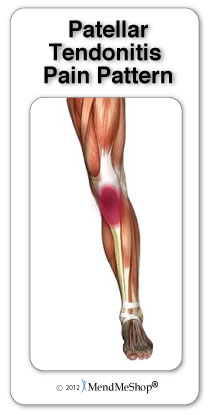
If any of those statements are true for you or you're suffering from on-going pain under your knee cap (patella) then you might have an injury called "Patellar Tendonitis". This type of tendonitis is usually an injury that athletes get, but it can happen to individuals who aren't athletes as well. Anyone - young or old - can suffer from this injury, and if you're active this condition will keep you from doing the things you love to do. It will even start interrupting your normal daily tasks and make living life harder than it really needs to be.
Tendonitis is a condition that is micro-tearing in the tendon tissue. When the knee is overworked or overstressed the damage to the soft tissue is done. Jumpers knee is most common in an aging athlete who is involved in 'jumping' sports such as basketball, volleyball and jogging.
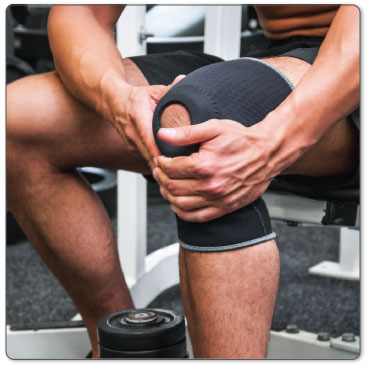
Patella Tendonitis can be caused by repetitive use of the patellar tendon, but can also be caused by trauma such as a blow to the knee. This condition is most common in an athlete who is involved in "jumping" sports such as basketball, gymnastics, figure skating, and volleyball. Other risk factors include:
There are a variety of internal and external causal factors for patellar tendonitis. Some outside factors would include overuse of your knee, wearing shoes that don't give you proper support, or athletic activity / exercising too much, too fast or for too long. Some internal factors include your age, flexibility, and the natural alignment of your feet, calves, knees and thighs.


The knee joint is made-up of 4 bones: the femur (thigh bone), fibula & tibia (shin bone), and the knee cap. The knee cap is a sesamoid bone, which means that it is a bone that's embedded in a tendon. For the knee cap this means that above the knee cap is the quadriceps tendon and below the knee cap is the patellar tendon. The patellar tendon attaches the knee cap, quadriceps tendon and quadriceps muscle to the shinbone below the knee. All of these elements work together to function as the "quadriceps mechanism" to help you when straightening your knee / leg.
The patellar tendon plays an important role in the way you use your leg muscles. The patellar tendon helps your muscles extend your knee so that you can kick a ball, run uphill and jump up in the air. This is why patella (patellar or 'infrapatellar') tendonitis is often called 'Jumper's knee'.
Jumper's Knee and patellar tendinopathy is a general term used to describe any kind of injury that causes irritation, tearing, or inflammation in the patellar tendon. There are different kinds of patellar tendinopathy that can happen that will influence how long you suffer from this injury, what type of treatment is needed and how to prevent further injury to your patellar tendon.
Short-term inflammation in the patellar tendon is considered 'patellar tendonitis'. This is where the tendon becomes frayed or torn from an incident (like playing sports / running), or over-use (repetitively participating in the same activities).
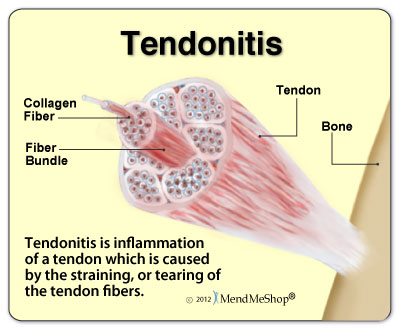
You may partially or completely tear your patellar tendon. If you completely tear your patellar tendon, your tendon will no longer be attached to your knee cap (patella). Without that attachment you won't be able to straighten your knee. Partial tearing usually happens to the middle of the patellar tendon, while complete tearing often happens where the patellar tendon connects to the knee cap (patella).
Patellar tendinosis happens when the tendon gets worn out over a long period of time (from overuse or aging of the tissue) and becomes damaged. This type of injury causes the tendon to thicken and micro-tear. Usually with tendinosis there isn't a lot of swelling or inflammation, just chronic, long-lasting pain.
If the protective lining of your tendon (called the 'tendon sheath') becomes irritated or damaged this is called 'tenosynovitis'. This condition happens to the inner lining of the sheath, and this irritation can happen from injury, overuse, or repetitive tasks.
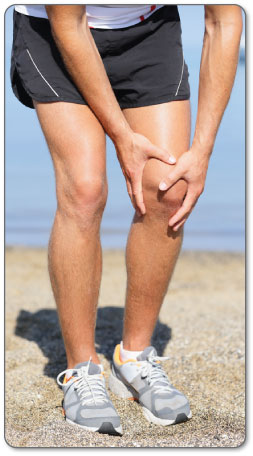
A visit to your doctor is the best way to know if you have patellar tendonitis. To properly diagnose your knee pain your doctor will ask about your medical history, your current condition and symptoms. They will ask your about the intensity of your present pain, how long you've had these symptoms and the limitations you're experiencing. Details about what you think may have caused the problem, when it started, and whether or not you have ever had treatments for this or a similar condition in the past, are very helpful in assessing your injury.
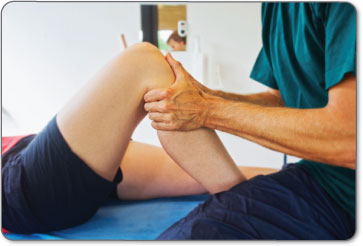
There are 2 tests your doctor may perform to decide if you have a patellar tendon injury:
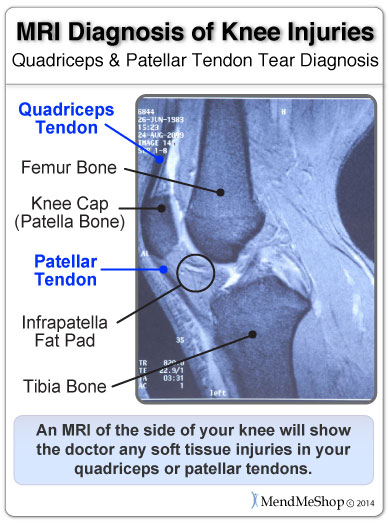
Both of these physical tests will help your doctor to determine a correct diagnosis of your knee pain. If for any reason the test(s) don't help to discover the source of your pain, then diagnostic testing (an X-ray and/or MRI) will be ordered. These tests are also often used to rule out other conditions.
X-rays will provide a 2-dimensional image of the overall structure of your knee. They're helpful in identifying knee instability, abnormal bone shapes (bone spurs or bone cysts, fractures, wear and tear on the joints).
MRIs (magnetic resonance imaging) will provide more detailed information and will help to evaluate the soft tissues in and around your knee (muscles, tendons, ligaments, menisci and other connective tissues). It can identify ligament or tendon damage, and can help to determine the extent of your injury, the displacement and degree of your tear or inflammation, as well as other associated knee conditions.
The first step for conservative treatment of tendonitis in the knee is to reduce the swelling to "open up" the area for more blood flow. Anyone in the health-care business knows that your blood supplies the oxygen and much needed nutrients required to heal knee tendonitis injuries. This is why for years, doctors, trainers, and other medical professionals have recommended RICE (Rest, Ice, Compression, Elevation) to treat the pain and swelling of fresh injuries, chronic pain, and after any re-injury.
This is important because once blood vessels are blocked or damaged, they can no longer carry oxygenated blood to your damaged tendon and tissues begin to break-down. Without cold compression, tissues break down further because they can't get the oxygen they need to survive. By limiting the amount of damage done to your tendons, you also limit the amount of healing that needs to occur. This is a very important step to heal acute or chronic tendon injuries faster and with less pain.
After the inflammation in your knee has been reduced, providing extra blood flow and strengthening the tissue around your knee is recommended.
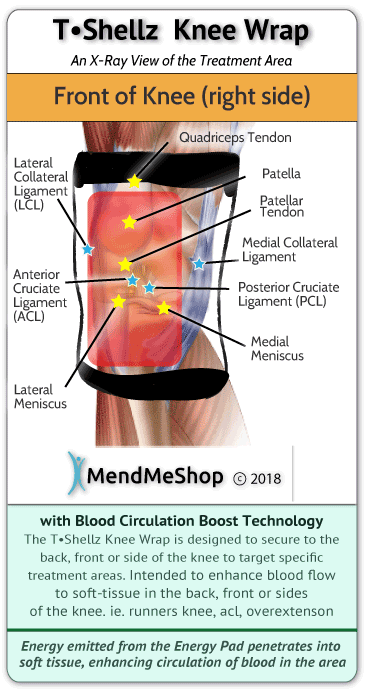
We believe the TShellz Wrap® to be one of the most effective treatments to stimulate blood flow to tissue in the treatment area.
We can promise that you will receive a product that is designed to be safe and does what it is supposed to do...quickly relieve pain and aid in the recovery from tendon, muscle and other soft tissue injuries.
The unit plugs into a standard wall outlet to get its power. The nice thing about the power supply is that the same unit can be used in North America and overseas as well. It has the capability to operate between 110v and 230v. It has a special signal controller that can be set for 3 different power levels of application (3=High, 2=Medium, 1=Low). The cord is long so you can sit or lie comfortably and watch TV, read or surf the net while you're using it.
We recommend 5 to 10 minute treatments to start; the safety shutoff controller is set to max 30 minutes in duration. The device can be worn over clothing and allows you to use the device at work, at home, or really anywhere you have access to an electrical outlet.
The most common question we receive from individuals prior to purchasing is - how many times a day should I be using my wrap and when should I be using them? While treatment plans will differ for each individual and their specific injury, there are general guidelines that should be adhered to.
The TShellz Wrap® would then be used:
Dealing with aches and pains affecting the foot, ankle, leg, knee, hamstring, hip, back, arm, shoulder, elbow, wrist, or hand? If so, then applying the Arnica Infusion to any of these targeted areas will bring about fast relief from the pain and sore tissues. Simply apply a small amount of cream to the body and moments later, you will experience a soothing and comforting sensation over the area.
Arnica Infusion is specially designed to relieve pain due to sore muscles and joints associated with arthritis, backaches, sprains, strains, and bruises. No matter if you are dealing with an acute injury, chronic pain, or a general "flare-up" - you will experience fast relief from pain and inflammation.
This is a product that many of our current MendMeShop customers asked us to develop. So we focused our time and resources over the past few years and came up, with we believe, will be one of more effective, fast acting, topical pain relief creams on the market.
You are likely familiar with some of the standard topical agents on the market as most of our customers use them. The are mass marketed and even found in most department stores now.
Well, we are here to say that Arnica Infusion goes many steps beyond what they offer.
Made in the USA at an FDA registered manufacturing facility, you can be assured that Arnica Infusion is both safe and effective. We only source top grade ingredients while implementing strict quality control checks during every step of the production process. Expect the same high quality that MendMeShop customers have been accustomed to since we started the company in 2005.
The "Cool Blue" formula is the perfect balance between the smooth application of a cream and the effective absorbing factor of a gel. It is not too thick and not too thin - just the right texture. Best of all, it feels very nice on the skin!
Each application of Arnica Infusion feels so comforting and soothing, we are certain it will become an item you will not want to live without.
The Arnica Infusion formula is based on a combination of scientific research and the use of high quality ingredients. The properties within the formula were chosen for their pain relief, anti-inflammatory, and soothing qualities.
The acting ingredients within the formula include ones many of us are familiar with; along with ones that have not received a lot of publicity (only in research circles). Extensive testing resulted in a blending of ingredients that provides the most synergistic of benefits.
The notable ingredients in the Arnica Infusion formula include:
Extensive quality control procedures during the manufacturing process ensure the ingredients and final product are both safe and effective. We would not stake our reputation on anything but the best.
Apply Arnica Infusion at work to help reduce acute discomfort associated with overuse of muscles and joints. No matter if you are in a physical demanding job or work within an office environment, you will be placing stress on different parts of the body and aches and pains will result.
If you suffer from a sprained ligament, pulled muscle, strained tendon, or even bruising - apply Arnica Infusion for quick relief of the pain.
Application of Arnica Infusion can be done up to a maximum of 4 times per day on a consistent basis to help bring about relief from various pains and aches.
Follow up your TShellz and Cold treatments with an application of Arnica Infusion. Combine the pain relieving benefits of Arnica Infusion along with the therapeutic benefits of the wraps to make your recovery go much more smoothly.
Do not apply Arnica Infusion within a 2 hour timespan before a TShellz Wrap® treatment.
Whether you decide to use the Arnica Infusion in conjunction with the T-Shell and other treatments - or if you decide to use the cream as a stand-alone product - you will not be disappointed with the results. We guarantee it.
Conservative treatment tools just like these have been used successfully by thousands of soft tissue injury sufferers - just like you.
We believe the use of TShellz® Circulatory Boost Wraps for boosting blood flow to soft tissue in the area of application is one of the most under-utilized home treatment options available on the market today. We have client after client that have tried many options out there and have been amazed at how effective and fast the TShellz Wrap treatment can relieve pain and increase blood flow in the treatment area.
With regular use of the TShellz® Circulatory Boost Wrap:
*Know that every personal soft tissue injury is unique and the TShellz Wrap may not work for everyone. This is why we offer a 60-day money back return on all our TShellz Wrap devices.
We all know that if the injury was healed, the pain would go away but what about the opposite situation? If the pain is gone, does that mean the injury is better? Unfortunately, this is not always true.
Too many people only focus on suppressing pain symptoms while providing less attention to the true healing aspects of the body. Experiencing less pain, while obviously a good short-term goal, does not equate to underlying healing. Scar tissue can remain for months after one gets to a point of being relatively pain-free. However, as long the weak and brittle scar tissue remains, you are susceptible to re-injury or re-aggravation. Certain motions or movements can cause the weaker tissue to easily tear - resulting in some reversal of the recovery up until that point.
This is why we recommend for people to continue with their doctor or therapist recommended exercises and to continue with mild treatments of the TShellz Wrap® for a period of time - to better ensure complete recovery.
Ongoing treatments to enhance circulation are intended to soothe, relax and promote healing of damaged soft tissue in the application area. T•Shellz treatment also results in the ability of soft tissue to extend further due to the effect of heat on soft tissue. The more extensible your tissues are, the less likely they are to strain or sprain.
People tell us all the time, "I was told that if I stay off my feet for a few weeks, my pain will disappear for good."
The truth is, tendonitis pain is usually a culmination of numerous factors, such as repetitive stress, poor posture, acute injuries, and overcompensation issues resulting from other muscle and soft tissue ailments.
It may take weeks or months for these pain triggers to surface. When they , however, merely resting will solve the underlying issues. You need to utilize actions and options that actually treat the source of the pain and help reverse the damage that has been done.
Resting has a role to play, but it is only one small factor in a recovery plan.
Product Advisors are available 9:00 am to 5:00 pm Eastern Standard Time Monday to Friday.
I want to learn more about Post-Surgery Recovery
I want to learn more about TShellz Wrap® Circulatory Boost
I want to learn more about Ice & Heat: Which Is Better For Treatment?
I want to learn more about Tendonitis Treatments
I want to learn more about Tendonitis Surgery
During your recovery, you will probably have to modify and/or eliminate any activities that cause pain or discomfort at the location of your soft tissue injury until the pain and inflammation settle. The more diligent you are with your treatment and rehabilitation, the faster you will see successful results!
Please be aware that this information is neither intended nor implied to be a substitute for professional medical advice. CALL YOUR HEALTHCARE PROVIDER IMMEDIATELY IF YOU THINK YOU MAY HAVE A MEDICAL EMERGENCY. Always seek the advice of your physician or other qualified health provider before using any of our outstanding products to make sure they are right for you and your condition or if you have any questions regarding a medical condition. Always see your doctor for a proper diagnosis as there are often many injuries and conditions (some very serious) that could be the cause of your pain.
© 2025 In.Genu Design Group, Inc. Contact Us